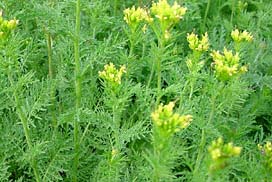Description
- Weed Description: Flixweed is found growing in disturbed habitats, fields, roadsides, and logged-over forests. It grows on a wide variety of soil types, but it is most abundant on dry, disturbed sites. It is often found along roadsides and ditches where mineral soil has been exposed (FEIS 1996).
- Leaves: Leaves are alternate, 2–3 times pinnately compound.
- Stems: Mature plants are 0.3–1.0 m tall.
- Flowers: Pale yellow, small, and produced in elongated racemes.
- Seeds: Seeds are borne in linear pods that are 11–33 mm long.
- Identifying Characteristics: Flixweed is an early-blooming winter annual or biennial and is one of the first weeds to appear in the spring. Flowering occurs from March through July, depending on geographic location. Flixweed spreads by seeds from early to late summer. Flixweed is an early seral species that quickly invades areas of exposed mineral soil with reduced plant cover. It can survive in dense stands for a few years if undisturbed but is generally replaced by other seral species (FEIS 1996). In later seral stages, flixweed competes poorly with perennial grasses and forbs.
(A Guide to Weeds in British Columbia)
Pest image (all)

Scientific name
Descurainia spp.
Pest photo source
http://www.enature.com/fieldguides/detail.asp?recNum=WF2239
Weed type
broadleaf
Production period
Preharvest
Weed life cycle
winter annual
